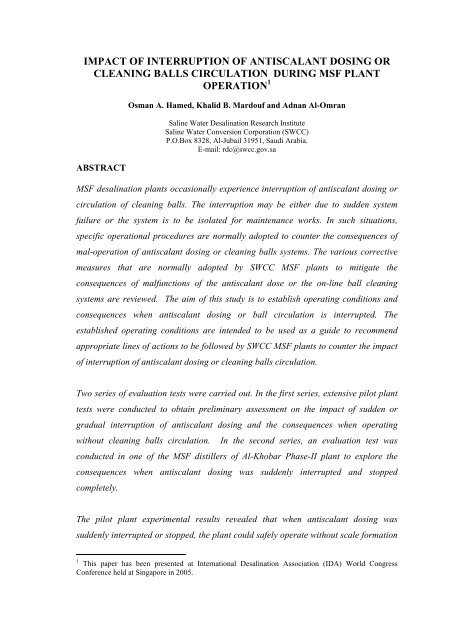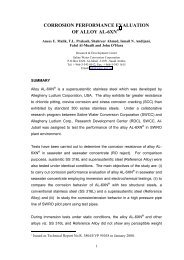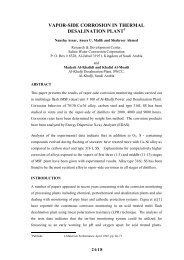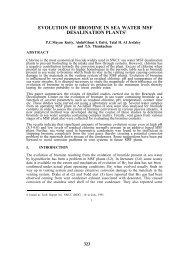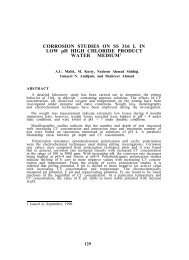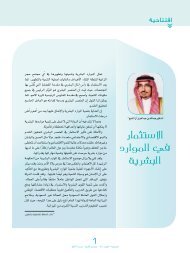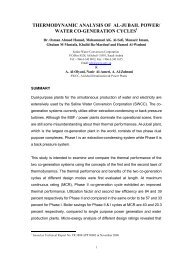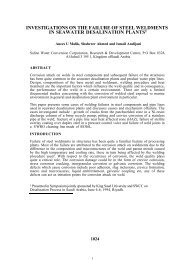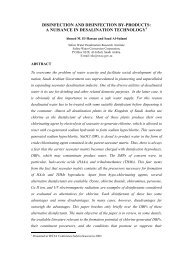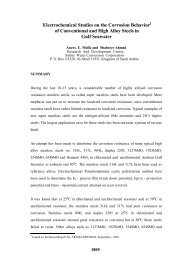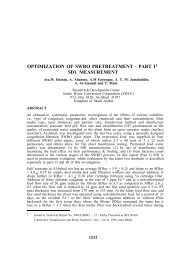impact of interruption of antiscalant dosing or cleaning balls ...
impact of interruption of antiscalant dosing or cleaning balls ...
impact of interruption of antiscalant dosing or cleaning balls ...
Create successful ePaper yourself
Turn your PDF publications into a flip-book with our unique Google optimized e-Paper software.
IMPACT OF INTERRUPTION OF ANTISCALANT DOSING OR<br />
CLEANING BALLS CIRCULATION DURING MSF PLANT<br />
OPERATION 1<br />
ABSTRACT<br />
Osman A. Hamed, Khalid B. Mardouf and Adnan Al-Omran<br />
Saline Water Desalination Research Institute<br />
Saline Water Conversion C<strong>or</strong>p<strong>or</strong>ation (SWCC)<br />
P.O.Box 8328, Al-Jubail 31951, Saudi Arabia.<br />
E-mail: rdc@swcc.gov.sa<br />
MSF desalination plants occasionally experience <strong>interruption</strong> <strong>of</strong> <strong>antiscalant</strong> <strong>dosing</strong> <strong>or</strong><br />
circulation <strong>of</strong> <strong>cleaning</strong> <strong>balls</strong>. The <strong>interruption</strong> may be either due to sudden system<br />
failure <strong>or</strong> the system is to be isolated f<strong>or</strong> maintenance w<strong>or</strong>ks. In such situations,<br />
specific operational procedures are n<strong>or</strong>mally adopted to counter the consequences <strong>of</strong><br />
mal-operation <strong>of</strong> <strong>antiscalant</strong> <strong>dosing</strong> <strong>or</strong> <strong>cleaning</strong> <strong>balls</strong> systems. The various c<strong>or</strong>rective<br />
measures that are n<strong>or</strong>mally adopted by SWCC MSF plants to mitigate the<br />
consequences <strong>of</strong> malfunctions <strong>of</strong> the <strong>antiscalant</strong> dose <strong>or</strong> the on-line ball <strong>cleaning</strong><br />
systems are reviewed. The aim <strong>of</strong> this study is to establish operating conditions and<br />
consequences when <strong>antiscalant</strong> <strong>dosing</strong> <strong>or</strong> ball circulation is interrupted. The<br />
established operating conditions are intended to be used as a guide to recommend<br />
appropriate lines <strong>of</strong> actions to be followed by SWCC MSF plants to counter the <strong>impact</strong><br />
<strong>of</strong> <strong>interruption</strong> <strong>of</strong> <strong>antiscalant</strong> <strong>dosing</strong> <strong>or</strong> <strong>cleaning</strong> <strong>balls</strong> circulation.<br />
Two series <strong>of</strong> evaluation tests were carried out. In the first series, extensive pilot plant<br />
tests were conducted to obtain preliminary assessment on the <strong>impact</strong> <strong>of</strong> sudden <strong>or</strong><br />
gradual <strong>interruption</strong> <strong>of</strong> <strong>antiscalant</strong> <strong>dosing</strong> and the consequences when operating<br />
without <strong>cleaning</strong> <strong>balls</strong> circulation. In the second series, an evaluation test was<br />
conducted in one <strong>of</strong> the MSF distillers <strong>of</strong> Al-Khobar Phase-II plant to expl<strong>or</strong>e the<br />
consequences when <strong>antiscalant</strong> <strong>dosing</strong> was suddenly interrupted and stopped<br />
completely.<br />
The pilot plant experimental results revealed that when <strong>antiscalant</strong> <strong>dosing</strong> was<br />
suddenly interrupted <strong>or</strong> stopped, the plant could safely operate without scale f<strong>or</strong>mation<br />
1 This paper has been presented at International Desalination Association (IDA) W<strong>or</strong>ld Congress<br />
Conference held at Singap<strong>or</strong>e in 2005.
f<strong>or</strong> a maximum period <strong>of</strong> 24 hours. When the MSF pilot plant was operated at TBT <strong>of</strong><br />
90 o C and brine recycle concentration ratio <strong>of</strong> 1.4 without circulation <strong>of</strong> <strong>cleaning</strong> <strong>balls</strong> ,<br />
the experimental results revealed that the effectiveness <strong>of</strong> a polycarboxylate based<br />
<strong>antiscalant</strong> in inhibiting scale f<strong>or</strong>mation was quite different compared to that <strong>of</strong> a<br />
phosphonate based <strong>antiscalant</strong>. Ball <strong>cleaning</strong> operation is highly influencing and<br />
effective when phosphonate based <strong>antiscalant</strong> is used. It has also been found that the<br />
threshold inhibition <strong>of</strong> the phosphonate based <strong>antiscalant</strong> with no ball <strong>cleaning</strong> at a<br />
dose rate <strong>of</strong> 1.0 ppm was m<strong>or</strong>e effective than that when using a relatively high dose rate<br />
<strong>of</strong> 3.0 ppm. Over-<strong>dosing</strong> <strong>of</strong> phosphonate based <strong>antiscalant</strong> with no ball <strong>cleaning</strong> was<br />
responsible f<strong>or</strong> f<strong>or</strong>mation <strong>of</strong> excessive sludge. Based on the preliminary tests which<br />
were carried out in the MSF pilot plant, it is recommended that plants which are using<br />
phosphonate based <strong>antiscalant</strong> have to review the c<strong>or</strong>rective actions which they<br />
n<strong>or</strong>mally follow in case <strong>of</strong> <strong>interruption</strong> <strong>of</strong> ball circulation<br />
Al-Khobar Phase-II plant evaluation test revealed that it is quite safe to operate the<br />
MSF distiller without <strong>antiscalant</strong> <strong>dosing</strong> f<strong>or</strong> a maximum period <strong>of</strong> three hours.<br />
1. INTRODUCTION<br />
1.1 Scale Control<br />
Scale f<strong>or</strong>mation on heat transfer surfaces, which is one <strong>of</strong> the basic problems in the<br />
desalination <strong>of</strong> seawater, can be effectively controlled <strong>or</strong> minimized by the addition <strong>of</strong><br />
chemical additives and use <strong>of</strong> on-line ball <strong>cleaning</strong>. A number <strong>of</strong> optimization tests<br />
have been carried out by SWCC thus leading to successful operation at low <strong>antiscalant</strong><br />
dose rates [1-9]. Recommended dose rates to SWCC in 1981 were 12.5 and 4.5 f<strong>or</strong><br />
TBT <strong>of</strong> 110 and 90 o C respectively [3] and are currently reduced to only 2.0 and 0.8<br />
ppm f<strong>or</strong> the respective temperatures. This significant reduction in dose rate is attributed<br />
to several fact<strong>or</strong>s such as improvement in chemical f<strong>or</strong>mulation, adoption <strong>of</strong> on-line<br />
sponge ball <strong>cleaning</strong> and plant operat<strong>or</strong> awareness to reduce chemical <strong>dosing</strong> while<br />
maintaining effective plant perf<strong>or</strong>mance.<br />
Although the f<strong>or</strong>mation <strong>of</strong> scale is combated and controlled by threshold treatment with<br />
the use <strong>of</strong> <strong>antiscalant</strong>, its complete prevention is impracticable. Sludge <strong>or</strong> dist<strong>or</strong>ted<br />
scale is also f<strong>or</strong>med because <strong>of</strong> threshold treatment, which is deposited on tube metallic
surfaces, and induces resistance to heat transfer. The combined use <strong>of</strong> chemical<br />
additives and on-line tube <strong>cleaning</strong> has been proved to be the most cost effective means<br />
to combat scale f<strong>or</strong>mation and to avoid frequent acid <strong>cleaning</strong> [10-12]. All SWCC<br />
MSF plants are using on-line sponge ball <strong>cleaning</strong>.<br />
1.2 Interruption <strong>of</strong> Antiscalant Dosing <strong>or</strong> Circulation <strong>of</strong> Cleaning Balls<br />
Commercial MSF desalination plants sometimes experience <strong>interruption</strong> <strong>of</strong> <strong>antiscalant</strong><br />
<strong>dosing</strong> <strong>or</strong> circulation <strong>of</strong> <strong>cleaning</strong> <strong>balls</strong>. Either the <strong>interruption</strong> may be due to sudden<br />
system failure <strong>or</strong> the system is needed to be isolated f<strong>or</strong> maintenance w<strong>or</strong>ks. In such<br />
circumstances, commercial plants n<strong>or</strong>mally adopt certain operating procedures to<br />
counter the consequences <strong>of</strong> mal-operation <strong>of</strong> <strong>antiscalant</strong> <strong>dosing</strong> <strong>or</strong> <strong>cleaning</strong> <strong>balls</strong><br />
systems.<br />
The c<strong>or</strong>rective measures that are n<strong>or</strong>mally adopted by SWCC MSF plants to mitigate<br />
the consequences <strong>of</strong> malfunctions <strong>of</strong> the <strong>antiscalant</strong> dose <strong>or</strong> the on-line ball <strong>cleaning</strong><br />
systems are varying. Generally, there are three different approaches, which are<br />
n<strong>or</strong>mally followed by SWCC MSF plants to counter the <strong>interruption</strong> and failure <strong>of</strong><br />
<strong>antiscalant</strong> <strong>dosing</strong> system. Al-Khafji, Shoaiba and Yanbu plants generally res<strong>or</strong>t to<br />
shut down the distiller immediately <strong>or</strong> employ cold circulation mode. The second<br />
group <strong>of</strong> plants, which include Al-Jubail, Al-Khobar and Shuqaiq, utilize continuous<br />
circulation <strong>of</strong> <strong>cleaning</strong> <strong>balls</strong> and reduce the top brine temperature to less than 90 o C.<br />
Jeddah plants, which represent the third approach, n<strong>or</strong>mally use the standby acid <strong>dosing</strong><br />
system when the <strong>antiscalant</strong> <strong>dosing</strong> system is malfunctioned.<br />
The remedial actions, which are n<strong>or</strong>mally followed by SWCC MSF plant when the ball<br />
<strong>cleaning</strong> system is inoperative, are also quite different. Al-Jubail plant prefers to solely<br />
increase the <strong>antiscalant</strong> dose rate by 50 per cent. Other plants fav<strong>or</strong> the increase <strong>of</strong><br />
<strong>antiscalant</strong> dose rate coupled either with the increase <strong>of</strong> the make-up flow such as Al-<br />
Khobar <strong>or</strong> Al-Khafji plants <strong>or</strong> with the reduction <strong>of</strong> the distiller production load as<br />
n<strong>or</strong>mally practiced in Yanbu plant. Jeddah plants can tolerate operation without ball<br />
<strong>cleaning</strong> f<strong>or</strong> a maximum period <strong>of</strong> one month when using phosphonate based<br />
<strong>antiscalant</strong> and six months with the use <strong>of</strong> polycarboxylate based <strong>antiscalant</strong>.
Very little research w<strong>or</strong>k has been published to rep<strong>or</strong>t the <strong>impact</strong> <strong>of</strong> the improper<br />
functioning <strong>of</strong> the <strong>antiscalant</strong> <strong>dosing</strong> <strong>or</strong> on-line ball <strong>cleaning</strong> systems on the thermal<br />
perf<strong>or</strong>mance <strong>of</strong> the MSF distillers.Al-S<strong>of</strong>i, et.al [13] rep<strong>or</strong>ted the perf<strong>or</strong>mance <strong>of</strong> MSF<br />
pilot plant when operated with extremely low dose rates with and without on-line<br />
sponge rubber ball <strong>cleaning</strong>. The <strong>impact</strong> <strong>of</strong> gradual dose rate reduction <strong>of</strong> phosphonatebase<br />
<strong>antiscalant</strong> on the thermal perf<strong>or</strong>mance <strong>of</strong> the MSF pilot plant operating with a<br />
TBT <strong>of</strong> 90 o C, was investigated. The <strong>antiscalant</strong> dose rate was reduced in a step-wise<br />
mode from 1.0 ppm to 0.0 ppm in five days time. The brine heater fouling fact<strong>or</strong><br />
increases, yet gradually, with the reduction in <strong>antiscalant</strong> dose rate. The pilot plant was<br />
also operated without ball <strong>cleaning</strong> at TBT <strong>of</strong> 90 o C and with a 1 ppm dose rate <strong>of</strong><br />
phosphonate base <strong>antiscalant</strong> Very gradual increase in the fouling fact<strong>or</strong> <strong>of</strong> the brine<br />
heater was observed.<br />
Al-Fraij et al. [14] rep<strong>or</strong>ted the trials carried out on two commercial MSF distillers that<br />
were operated at TBT <strong>of</strong> 103 o C and 105 o C without the circulation <strong>of</strong> <strong>cleaning</strong> <strong>balls</strong><br />
using two different types <strong>of</strong> <strong>antiscalant</strong>s. To alleviate the consequences <strong>of</strong> operating<br />
without ball circulation, the <strong>antiscalant</strong> <strong>dosing</strong> rates were increased by 50 to 100%.<br />
The objectives <strong>of</strong> this paper are two folds:<br />
(1) To establish operating conditions and consequences when <strong>antiscalant</strong> <strong>dosing</strong> <strong>or</strong><br />
ball circulation are interrupted.<br />
(2) To recommend appropriate lines <strong>of</strong> actions that is to be followed by commercial<br />
MSF plants to counter the <strong>impact</strong> <strong>of</strong> <strong>interruption</strong> <strong>of</strong> <strong>antiscalant</strong> <strong>dosing</strong> <strong>or</strong> <strong>cleaning</strong><br />
<strong>balls</strong> circulation.<br />
2. EXPERIMENTAL METHODOLOGY<br />
Two series <strong>of</strong> evaluation tests were carried out. In the first series, extensive pilot plant<br />
tests were conducted to obtain preliminary assessment on the <strong>impact</strong> <strong>of</strong> sudden <strong>or</strong><br />
gradual <strong>interruption</strong> <strong>of</strong> <strong>antiscalant</strong> <strong>dosing</strong> and the consequences when operating without<br />
<strong>cleaning</strong> <strong>balls</strong> circulation. In the second series, an evaluation test was conducted in one<br />
<strong>of</strong> the MSF distillers <strong>of</strong> Al-Khobar Phase-II plant to expl<strong>or</strong>e the consequences when<br />
<strong>antiscalant</strong> <strong>dosing</strong> was suddenly interrupted and stopped completely.
2.1 Pilot Plant Test<br />
2.1.1 Test Location<br />
F<strong>or</strong> preliminary evaluation tests the MSF pilot plant <strong>of</strong> RDC was selected. This pilot<br />
unit consists <strong>of</strong> 4 stages in the heat recovery section and 2 stages in the heat rejection<br />
section. Its design capacity is 20 ton/day and it has all the imp<strong>or</strong>tant features <strong>of</strong> an<br />
MSF commercial plant. Make-up seawater can be given additive and/<strong>or</strong> acid treatment<br />
inclusive <strong>of</strong> external deaeration and decarbonation. Scale control by <strong>antiscalant</strong><br />
chemical is complemented by two separate rubber ball <strong>cleaning</strong> loops. There is also a<br />
provision <strong>of</strong> acid <strong>cleaning</strong> <strong>of</strong> heat transfer tubes (brine heater) with and without<br />
recovery section tubes.<br />
It can provide sufficiently good initial indication f<strong>or</strong> the purpose <strong>of</strong> the study. Heat<br />
transfer coefficients and fouling fact<strong>or</strong>s were monit<strong>or</strong>ed during the tests.<br />
2.1.2 Test Plan and Conditions<br />
Two successive groups <strong>of</strong> tests were carried out. In the first group, the <strong>impact</strong> <strong>of</strong><br />
<strong>interruption</strong> <strong>of</strong> <strong>antiscalant</strong> <strong>dosing</strong> on the thermal perf<strong>or</strong>mance <strong>of</strong> the MSF pilot plant<br />
was th<strong>or</strong>oughly investigated. In the second subsequent group, the consequences <strong>of</strong><br />
operating the pilot plant without ball cycling in the brine heater and heat recovery<br />
section were expl<strong>or</strong>ed. The evaluation tests <strong>of</strong> the two groups are detailed as follows:<br />
Group -I<br />
In the first group, two evaluation tests were carried out to examine the consequences <strong>of</strong><br />
<strong>interruption</strong> <strong>of</strong> <strong>antiscalant</strong> <strong>dosing</strong> which are :<br />
1. Stepwise reduction <strong>of</strong> dose rate <strong>of</strong> phosphonate <strong>or</strong> polycarboxylate based<br />
<strong>antiscalant</strong>s from 1.0 ppm down to 0.0 ppm at TBT <strong>of</strong> 90 o C.<br />
2. Abrupt dose rate reduction from 1.0 ppm to 0.0 <strong>of</strong> phosphonate and<br />
polycarboxylate based <strong>antiscalant</strong>s at TBT <strong>of</strong> 100 o C.<br />
Group-II<br />
In the second group, two evaluation tests were carried out to study the <strong>impact</strong> <strong>of</strong><br />
<strong>cleaning</strong> <strong>balls</strong> <strong>interruption</strong> on the unit perf<strong>or</strong>mance.
1. The pilot plant was operated without ball cycling at TBT <strong>of</strong> 90 o C using either<br />
phosphonate <strong>or</strong> polycarboxylate based <strong>antiscalant</strong>s at TBT <strong>of</strong> 90 o C with a dose<br />
rate <strong>of</strong> 1.0 ppm.<br />
2. To investigate the <strong>impact</strong> <strong>of</strong> <strong>antiscalant</strong> over<strong>dosing</strong>, the pilot plant was operated<br />
with no ball circulation at TBT <strong>of</strong> 100 o C and with a relatively high dose rate <strong>of</strong><br />
3.0 ppm <strong>of</strong> the sludge f<strong>or</strong>ming phosphonate based <strong>antiscalant</strong>.<br />
2.2 Commercial Plant Test<br />
Unit # 8 <strong>of</strong> Al-Khobar Phase-II MSF plant was selected to expl<strong>or</strong>e the consequence<br />
when <strong>antiscalant</strong> <strong>dosing</strong> was suddenly interrupted and stopped completely. The<br />
evap<strong>or</strong>at<strong>or</strong> is designed as additive control process with recirculating brine flow regime<br />
through the cross tube configuration. The distiller is designed to produce 5 MIGD at<br />
TBT <strong>of</strong> 90 o C with provision to go up in production to 6.7 MIGD at TBT <strong>of</strong> 115 o C.<br />
The distiller is currently operating at TBT <strong>of</strong> around 90 o C. Scale control is attained<br />
through the combined continuous injection <strong>of</strong> polycarboxylate based <strong>antiscalant</strong> with a<br />
dose rate <strong>of</strong> 1 ppm and circulation <strong>of</strong> <strong>cleaning</strong> <strong>balls</strong>. On-line ball <strong>cleaning</strong> operation is<br />
n<strong>or</strong>mally carried out once every shift and with 9 cycles per shift.<br />
3. RESULTS AND DISCUSSION<br />
3.1 Pilot Plant Tests<br />
3.1.1 Antiscalant Interruption<br />
3.1.1.1 Stepwise Reduction <strong>of</strong> Antiscalant Dose Rate<br />
Bef<strong>or</strong>e assessing the <strong>impact</strong> <strong>of</strong> sudden <strong>interruption</strong> <strong>of</strong> <strong>antiscalant</strong> <strong>dosing</strong> and as a<br />
precautionary step and in <strong>or</strong>der to make a direct comparison between the perf<strong>or</strong>mances<br />
<strong>of</strong> two <strong>antiscalant</strong>s <strong>of</strong> different chemical structures which are polycarboxylate and<br />
phosphonate based <strong>antiscalant</strong>s, two preliminary evaluation tests were first carried out.<br />
The primary objective <strong>of</strong> these two tests was to determine the <strong>impact</strong> <strong>of</strong> gradual<br />
reduction <strong>of</strong> <strong>antiscalant</strong> dose rate when the MSF pilot plant was operating at 90 o C,<br />
brine concentration ratio <strong>of</strong> 1.4 and the ball <strong>cleaning</strong> circulation was in n<strong>or</strong>mal<br />
operation. Figures 1 and 2 show the variation <strong>of</strong> the overall heat transfer coefficient<br />
(OHTC) and the fouling fact<strong>or</strong> (FF) <strong>of</strong> the brine heater f<strong>or</strong> phosphonate and<br />
polycarboxylate based <strong>antiscalant</strong>s, respectively.
Figure 1 reveals that the OHTC and the FF remained virtually constant when the dose<br />
rate <strong>of</strong> the phosphonate based <strong>antiscalant</strong> was reduced in a stepwise mode from 1.0<br />
ppm to 0.4 ppm. Conversely, when the dose rate was reduced further to 0.2 ppm, the<br />
unit started to be fouled and the FF increased from 0.05 to 0.1 m 2 K/kW. When the<br />
<strong>antiscalant</strong> <strong>dosing</strong> was completely stopped, the FF increased significantly from 0.1 to<br />
0.17 m 2 K/kW.<br />
Figure 2 demonstrates that f<strong>or</strong> polycarboxylate based <strong>antiscalant</strong>, the OHTC and FF<br />
during the dose rate range <strong>of</strong> 0.8 ppm down to 0.2 ppm were almost maintained<br />
constant and there was no indication <strong>of</strong> scale f<strong>or</strong>mation. However, when the <strong>antiscalant</strong><br />
<strong>dosing</strong> was completely discontinued, the FF increased significantly from 0.05 to 0.23<br />
m 2 K/kW within three days time.<br />
Comparison <strong>of</strong> the test results depicted in Figures 1 and 2 disclose that phosphonate<br />
and Polycarboxylate based <strong>antiscalant</strong>s will allow pilot plant operation safely down to a<br />
dose rate <strong>of</strong> 0.4 at TBT <strong>of</strong> 90 o C with continuous circulation <strong>of</strong> <strong>cleaning</strong> <strong>balls</strong>.<br />
3.1.1.2 Abrupt Reduction <strong>of</strong> Antiscalant Dose Rate<br />
Two evaluation tests were carried out to determine the <strong>impact</strong> <strong>of</strong> sudden <strong>interruption</strong> <strong>of</strong><br />
<strong>antiscalant</strong> <strong>dosing</strong> on the perf<strong>or</strong>mance <strong>of</strong> the MSF pilot plant. The unit was operated at<br />
a TBT <strong>of</strong> 100 o C, brine concentration ratio <strong>of</strong> 1.4 and with continuous <strong>cleaning</strong> ball<br />
circulation using two different <strong>antiscalant</strong>s. The test results <strong>of</strong> the two examined<br />
<strong>antiscalant</strong>s, which are shown in Figures 3 and 4 disclose that the two <strong>antiscalant</strong>s are<br />
m<strong>or</strong>e <strong>or</strong> less exhibiting the same behavi<strong>or</strong>. The OHTC and the FF <strong>of</strong> the brine heater<br />
were virtually remained constant f<strong>or</strong> a period <strong>of</strong> about 24 hours. Although the<br />
<strong>antiscalant</strong> <strong>dosing</strong> was completely discontinued during this 24 hour period, the residual<br />
quantity <strong>of</strong> <strong>antiscalant</strong> succeeded in suppressing scale f<strong>or</strong>mation. It has been concluded<br />
that if <strong>antiscalant</strong> <strong>dosing</strong> is suddenly interrupted <strong>or</strong> stopped, the pilot plant can safely<br />
operate f<strong>or</strong> a maximum period <strong>of</strong> 24 hours.<br />
In spite that the MSF pilot plant is simulating the operational perf<strong>or</strong>mance <strong>of</strong> a<br />
commercial MSF distiller to a large extent, there are still some operational disparities<br />
between the two units. Particularly the residence time <strong>of</strong> the brine recycle during its
passing through the tubes <strong>of</strong> the brine heater and heat recovery section <strong>of</strong> the pilot<br />
plant, is much lower than that experienced in the commercial unit. It is thus expected<br />
that when the <strong>antiscalant</strong> <strong>dosing</strong> is suddenly stopped in a commercial plant, the safe<br />
period that would not seriously affect the plant thermal perf<strong>or</strong>mance shall be much less<br />
than 24 hours. It is recommended that an actual test is to be conducted in a selected<br />
commercial distiller to identify the consequences <strong>of</strong> completely stopping the <strong>antiscalant</strong><br />
<strong>dosing</strong> f<strong>or</strong> a prescribed period <strong>of</strong> time (e.g. 8 hours).<br />
3.1.2 Interruption <strong>or</strong> Failure <strong>of</strong> On-line Ball Cleaning System<br />
The MSF pilot plant was first operated at TBT 90 o C and brine recycle concentration<br />
ratio <strong>of</strong> 1.4 without circulation <strong>of</strong> <strong>cleaning</strong> <strong>balls</strong> using successively two different<br />
<strong>antiscalant</strong>s (phosphonate and polycarboxylate based <strong>antiscalant</strong>s). The results <strong>of</strong> the<br />
two evaluation tests are shown in Figures 5 and 6. Figure 5 shows the <strong>impact</strong> <strong>of</strong> no<strong>cleaning</strong><br />
ball circulation on the perf<strong>or</strong>mance <strong>of</strong> the MSF pilot plant using phosphonate<br />
based <strong>antiscalant</strong>. F<strong>or</strong> the first 80 hours <strong>of</strong> operation, suspension <strong>of</strong> <strong>cleaning</strong> ball<br />
circulation did not result in deteri<strong>or</strong>ation <strong>of</strong> the unit thermal perf<strong>or</strong>mance and it can thus<br />
be considered as a tolerable time margin. Afterwards, the FF <strong>of</strong> the brine heater started<br />
to rise sharply reaching the unit design fouling fact<strong>or</strong> in a period <strong>of</strong> almost 320 hours.<br />
When the ball <strong>cleaning</strong> circulation was resumed the FF dropped significantly to a value<br />
which was comparable to the FF value at the test onset. This behavi<strong>or</strong> indicates that the<br />
scale f<strong>or</strong>med was in sludge f<strong>or</strong>m and which can easily be removed by call circulation.<br />
Figure 6 reveals that the effectiveness <strong>of</strong> polycarboxylate based <strong>antiscalant</strong> in inhibiting<br />
scale f<strong>or</strong>mation when the ball <strong>cleaning</strong> system was inoperative, was quite different<br />
compared to that <strong>of</strong> phosphonate based <strong>antiscalant</strong>. In spite <strong>of</strong> the fact that the pilot<br />
plant was operated f<strong>or</strong> a period <strong>of</strong> m<strong>or</strong>e than 350 hours without ball <strong>cleaning</strong>, the unit<br />
thermal perf<strong>or</strong>mance was very slightly influenced which was reflected in the very low<br />
rise <strong>of</strong> the brine heater fouling fact<strong>or</strong>. When ball <strong>cleaning</strong> was resumed after the elapse<br />
<strong>of</strong> 370 hours <strong>of</strong> operation without ball <strong>cleaning</strong>, the FF was slightly reduced. It can<br />
thus be derived that the influence <strong>of</strong> operation without ball <strong>cleaning</strong> (f<strong>or</strong> a period <strong>of</strong> 370<br />
hours) when polycarboxylate based <strong>antiscalant</strong> is insignificant.
Direct comparison <strong>of</strong> Figures 5 and 6 show that the ball <strong>cleaning</strong> operation is highly<br />
needed and it is effective when phosphonate based <strong>antiscalant</strong> is used. This deduction<br />
is consistent with the findings rep<strong>or</strong>ted earlier by Al-Zahrani, et.al [6].<br />
To investigate further the <strong>impact</strong> <strong>of</strong> no-ball <strong>cleaning</strong> operation on the effectiveness <strong>of</strong><br />
phosphonate based <strong>antiscalant</strong>, two consecutive tests were carried out. The results are<br />
shown in Figure 7. In the first test, the pilot plant was operated at TBT <strong>of</strong> 100 o C<br />
without ball cycling and with a relatively high dose rate <strong>of</strong> phosphonate based<br />
<strong>antiscalant</strong>, that was 3 ppm. In a period <strong>of</strong> 130 hours the brine heater FF almost<br />
approached the design value. Ball <strong>cleaning</strong> cycling was resumed and the <strong>or</strong>iginal FF <strong>of</strong><br />
the unit was rest<strong>or</strong>ed. The test was then carried out with a lower dose rate <strong>of</strong> 1.0 ppm.<br />
It took around 200 hours – a period which was longer than that obtained with a dose<br />
rate <strong>of</strong> 3 ppm - to reach the targeted FF. The threshold inhibition <strong>of</strong> the phosphonate<br />
based <strong>antiscalant</strong> with no ball <strong>cleaning</strong> at a dose rate <strong>of</strong> 1.0 ppm was thus m<strong>or</strong>e<br />
effective than that when using a relatively high dose rate <strong>of</strong> 3.0 ppm. Over-<strong>dosing</strong> <strong>of</strong><br />
the phosphonate based <strong>antiscalant</strong> with no ball <strong>cleaning</strong> was responsible f<strong>or</strong> f<strong>or</strong>mation<br />
<strong>of</strong> excessive sludge. The maj<strong>or</strong>ity <strong>of</strong> SWCC’s MSF plants as described in Section 1.2<br />
prefer to increase <strong>antiscalant</strong> dose to counter the negative <strong>impact</strong> <strong>of</strong> <strong>interruption</strong> <strong>of</strong><br />
<strong>cleaning</strong> <strong>balls</strong> circulation.<br />
Based on the preliminary tests, which were carried out in the MSF pilot plant, it is<br />
recommended that plants which are using phosphonate based <strong>antiscalant</strong> have to<br />
review the remedial actions, which they follow in case <strong>of</strong> <strong>interruption</strong> <strong>of</strong> ball<br />
circulation.<br />
3.2 Commercial Plant Test<br />
An evaluation test was conducted in unit # 8 <strong>of</strong> Al-Khobar Phase-II MSF plant to<br />
expl<strong>or</strong>e the consequences when <strong>antiscalant</strong> <strong>dosing</strong> was suddenly interrupted and<br />
stopped completely. The evaluation test was carried out on Monday 28 th July, 2004. At<br />
7.10 a.m. the <strong>antiscalant</strong> <strong>dosing</strong> was completely stopped and n<strong>or</strong>mal ball <strong>cleaning</strong><br />
operation was maintained throughout the whole test period. Comprehensive chemical<br />
analyses were carried out <strong>of</strong> the most imp<strong>or</strong>tant liquid streams which included:<br />
• Seawater make-up
• Brine recycle entering and leaving the heat recovery section<br />
• Brine recycle leaving the brine heater<br />
• Brine blow down<br />
• Product water<br />
The most imp<strong>or</strong>tant parameters which were monit<strong>or</strong>ed during the test were pH,<br />
conductivity, TDS, chl<strong>or</strong>ides, M-Alkalinity, loss <strong>of</strong> total alkalinity, calcium,<br />
magnesium and total hardness.<br />
Figure 8 shows the variation <strong>of</strong> loss <strong>of</strong> total alkalinity (LTA) <strong>of</strong> the brine recycle<br />
leaving the brine heater with time. The LTA shall give an estimate <strong>of</strong> the quantity scale<br />
deposited in the heat recycle and brine heater. Point A in Fig. 8 represents the<br />
condition at the onset <strong>of</strong> the test and when the <strong>antiscalant</strong> <strong>dosing</strong> was completed<br />
stopped. During the period <strong>of</strong> <strong>antiscalant</strong> <strong>interruption</strong>, the LTA started to increase.<br />
During the first three hours the LTA increased gradually from 1.0 ppm to 5.5 ppm as<br />
indicated by line AB. Afterwards LTA increased exponentially with time and at point C<br />
it reached a value <strong>of</strong> around 20 ppm after five hours. Antiscalant injection was then<br />
resumed with a relatively high dose rate <strong>of</strong> 2 ppm f<strong>or</strong> a 30 minutes period and then<br />
reduced to n<strong>or</strong>mal dose rate <strong>of</strong> 1 ppm. In the mean time, the ball <strong>cleaning</strong> system was<br />
started and kept in operation continuously f<strong>or</strong> four hours.<br />
The LTA dropped significantly and was maintained consistently below 5 ppm. It is<br />
concluded a period <strong>of</strong> three hours can be considered as a quite safe period to operate the<br />
MSF distiller without <strong>antiscalant</strong> <strong>dosing</strong>. During this three hours period the residual<br />
<strong>antiscalant</strong> in the brine recycle was effective in the control <strong>of</strong> scale f<strong>or</strong>mation and<br />
maintain the LTA within a safe limit.<br />
4. CONCLUSIONS<br />
1. The various c<strong>or</strong>rective measures that are n<strong>or</strong>mally adopted by SWCC MSF plants<br />
to mitigate the consequences <strong>of</strong> malfunctions <strong>of</strong> the <strong>antiscalant</strong> dose <strong>or</strong> the on-line<br />
ball <strong>cleaning</strong> systems are reviewed.<br />
2. The operating conditions and consequences when <strong>antiscalant</strong> <strong>dosing</strong> <strong>or</strong> ball<br />
circulation was interrupted using two different <strong>antiscalant</strong>s were established.
3. The phosphonate and polycarboxylate based <strong>antiscalant</strong>s will allow pilot plant<br />
operation safely down to a dose rate <strong>of</strong> 0.4 at TBT <strong>of</strong> 90 o C with continuous<br />
circulation <strong>of</strong> <strong>cleaning</strong> <strong>balls</strong>.<br />
4. The extensive pilot plant experimental results revealed that when <strong>antiscalant</strong><br />
<strong>dosing</strong> was suddenly interrupted <strong>or</strong> stopped, the plant could safely operate<br />
without scale f<strong>or</strong>mation f<strong>or</strong> a maximum period <strong>of</strong> 24 hours.<br />
5. When the MSF pilot plant was operated without circulation <strong>of</strong> <strong>cleaning</strong> <strong>balls</strong>, the<br />
effectiveness <strong>of</strong> polycarboxylate based <strong>antiscalant</strong> in inhibiting scale f<strong>or</strong>mation<br />
was quite different compared to that <strong>of</strong> phosphonate based <strong>antiscalant</strong>. Ball<br />
<strong>cleaning</strong> operation is highly effective when phosphonate based <strong>antiscalant</strong> was<br />
used. Conversely, the influence <strong>of</strong> operation without ball <strong>cleaning</strong> on the<br />
perf<strong>or</strong>mance <strong>of</strong> the pilot plant using polycarboxylate based <strong>antiscalant</strong> is<br />
insignificant.<br />
6. It has also been found that the threshold inhibition <strong>of</strong> phosphonate based<br />
<strong>antiscalant</strong> with no ball <strong>cleaning</strong> at a dose rate <strong>of</strong> 1.0 ppm was m<strong>or</strong>e effective than<br />
that when using a relatively high dose rate <strong>of</strong> 3.0 ppm. Over-<strong>dosing</strong> <strong>of</strong><br />
phosphonate based <strong>antiscalant</strong> with no ball <strong>cleaning</strong> was responsible f<strong>or</strong><br />
f<strong>or</strong>mation <strong>of</strong> excessive sludge.<br />
7. Al-Khobar Phase-II plant evaluation test revealed it is quite safe to operate the<br />
MSF distiller without <strong>antiscalant</strong> <strong>dosing</strong> f<strong>or</strong> a maximum period <strong>of</strong> 3 hours.<br />
5. ACKNOWLEDGEMENT<br />
The effective cooperation and supp<strong>or</strong>t extended by the following engineers and<br />
chemists <strong>of</strong> the R&D Center and Al-Khobar Power & Desalination Plant to carry out<br />
the <strong>antiscalant</strong> <strong>interruption</strong> test in Al-Khobar Phase-II is gratefully acknowledged.<br />
R&D Center<br />
Al-Khobar Plant<br />
1. Eng. Ali Al-Wadie 1. Eng. Khalid Hussein Al-Omarie<br />
2. Eng. Hulail Al-Otaibi 2. Chemist/Mohd. A. Al-Brekan<br />
3. Chemist/Saleh H. Al-Bathi<br />
4. Chemist/Abdel Salam A. Al-Rawaishid<br />
5. Chemist/Sami Mohd. Al-Sharikh<br />
6. Chemist/Mohd. Shah Zaman<br />
7. Lab Tech./Khalid Nassir Al-Mansour
6. REFERENCES<br />
1. Hamed, O.A., Al-S<strong>of</strong>i, M.AK., Imam, M., Ba Mardouf, K.,.Al-Mobayed, A.S and Ehsan,<br />
A., (1996), DSB(M) Antiscalant Testing at low dose rate, Research & Development<br />
Center, Rep<strong>or</strong>t No. TSR-3808/97026 Part I.<br />
2. Hamed, O.A., Al-S<strong>of</strong>i, M.AK., Imam, M., Ba Mardouf, K.,.Al-Mobayed, A.S and Ehsan,<br />
A., (1998), DSB(M) Antiscalant Testing at low dose rate in Al-Jubail Plant, Research &<br />
Development Center, Rep<strong>or</strong>t No. TSR-3808/97026 Part II.<br />
3. Al-S<strong>of</strong>i, M.AK., Al-Husain, M.A. and Al-Zahrani, S., (1987), Additive Scale Control<br />
Optimization and Operation Modes, Desalination, 66, pp. 11-32.<br />
4. Al-Mudaiheem, A.M.A. and Szostack, R.M., (1986), Evaluation <strong>of</strong> Chemical Additives<br />
f<strong>or</strong> Scale Control in MSF Plants, Topics in Desalination (13), SWCC, Saudi Arabia.<br />
5. Nada, N., (1986), Evaluation <strong>of</strong> Various Additives at Al-Jubail Phase-I during Reliability<br />
Trials, Topic in Desalination No. 13, SWCC, Saudi Arabia.<br />
6. Al-Zahrani, S., Al-Ajlan, A.M. and Al-Jardan, A.M., (1993), Using Different Type <strong>of</strong><br />
Antiscalants at the Al-Jubail Power and Desalination Plant in Saudi Arabia. Proceedings<br />
<strong>of</strong> IDA and WRPC W<strong>or</strong>ld Conference on Desalination and Water Treatment, Yokohama,<br />
Japan, Vol. 1, pp. 421-431.<br />
7. Al-S<strong>of</strong>i, M.AK., Al-Husain, M.A., Al-Omran, A.A. and Farran, K.M. , (1994), A Full<br />
Decade <strong>of</strong> Operating Experience on Al-Khobar-II Multistage Flash (MSF) Evap<strong>or</strong>at<strong>or</strong>s<br />
(1982-1992), Desalination, 96, pp. 313-323.<br />
8. Al-S<strong>of</strong>i, M.AK., Khalaf, S. and Al-Omran, A.A., (1989), Practical Experience in Scale<br />
Control, Desalination, 73, pp. 313-325.<br />
9. Hamed, O.A., Al-S<strong>of</strong>i, M.AK., Mustafa, G.M. and Dalvi, A.G.I., (1999), The<br />
perf<strong>or</strong>mance <strong>of</strong> different <strong>antiscalant</strong>s in multistage flash distillers, Desalination, 123, 185-<br />
194.<br />
10. Böhmer, H., (1998), On-line sponge ball <strong>cleaning</strong> system. Encyclopedia <strong>of</strong> Desalination<br />
and Water Resource. Chapter II.<br />
11. Böhmer, H., (1993), On-line tube <strong>cleaning</strong> systems and debris filters f<strong>or</strong> avoidance <strong>of</strong><br />
micr<strong>of</strong>ouling in MSF desalination systems, Desalination, 93, p.171.<br />
12. Al-S<strong>of</strong>i, M.AK., (1999), Fouling Phenomena in Multistage Flash (MSF)<br />
distillers.Desalination,126, pp.61-76.<br />
13. Al-S<strong>of</strong>i, M.AK, Hamed, O.A., Bamardouf, K., Dalvi, A.I., Al-Washmi, H., Kither, M.A.,<br />
and Al-Aseeri, Y., (2001), Availability safety margins <strong>of</strong> time and <strong>antiscalant</strong> dose rate”,<br />
Desalination J., Vol. 134, 242-247.<br />
14. Al-Fraij, K.M., Al-Adwani, A.A. and Al-Romh, M.K., (2001), Efficiency <strong>of</strong> two<br />
multistage flash distillation units operation at 103 o C and 105 o C with ball <strong>cleaning</strong> system<br />
inoperative – Case study, Proceedings <strong>of</strong> IDA Conference, Bahrain.
8<br />
1.2<br />
7<br />
0.8<br />
Overall Heat Transfer<br />
Coefficie nt, kW /m 2 K<br />
Dose rate (ppm)<br />
6<br />
0.4<br />
5<br />
0<br />
4<br />
-0.4<br />
3<br />
-0.8<br />
U Design<br />
=2.491<br />
2<br />
-1.2<br />
0 20 40 60 80 100 120 140 160 180 200<br />
Hours<br />
Dose Rate ppm<br />
0.5<br />
1.2<br />
Fouling Fact<strong>or</strong>, m 2 K/kW<br />
0.4<br />
0.3<br />
0.2<br />
0.1<br />
FF Design = 0.215<br />
Dose rate (ppm)<br />
0.8<br />
0.4<br />
0<br />
-0.4<br />
-0.8<br />
Dose Rate ppm<br />
0<br />
-1.2<br />
0 20 40 60 80 100 120 140 160 180 200<br />
Hours<br />
Figure 1. Impact <strong>of</strong> gradual dose rate reduction <strong>of</strong> phosphonate based<br />
<strong>antiscalant</strong> on brine heater Perf<strong>or</strong>mance at TBT <strong>of</strong> 90 o C<br />
8<br />
1.2<br />
Overall Heat Transfer<br />
Coefficient, kW /m 2 .K<br />
7<br />
6<br />
5<br />
4<br />
3<br />
0.8<br />
0.4<br />
0<br />
-0.4<br />
-0.8<br />
Dose Rate, ppm<br />
2<br />
0 100 200 300 400 500 600<br />
Time, Hours<br />
-1.2<br />
0.5<br />
1.2<br />
Fouling Fact<strong>or</strong>, m 2 .K/kW<br />
0.4<br />
0.3<br />
0.2<br />
0.1<br />
Design Value = 0.215 m 2 .K/kW<br />
0.8<br />
0.4<br />
0<br />
-0.4<br />
-0.8<br />
Dose Rate, ppm<br />
0<br />
-1.2<br />
0 100 200 300 400 500 600<br />
Time, Hours<br />
Figure 2. Impact <strong>of</strong> gradual dose rate reduction <strong>of</strong> polycarboxylate based<br />
<strong>antiscalant</strong> on brine heater perf<strong>or</strong>mance at TBT <strong>of</strong> 90 o C
HTC, kW/m2K<br />
5<br />
4.5<br />
4<br />
3.5<br />
3<br />
2.5<br />
2<br />
0 8 16 24 32 40 48 56 64 72<br />
0.4<br />
FF, m2K/kW<br />
0.3<br />
0.2<br />
0.1<br />
0<br />
0 8 16 24 32 40 48 56 64 72<br />
Hours<br />
Figure 3. The <strong>impact</strong> <strong>of</strong> sudden cutting <strong>of</strong> phosphonate based<br />
<strong>antiscalant</strong> <strong>dosing</strong> at TBT 100 o C and 1.0 ppm with<br />
continuous cycling <strong>of</strong> <strong>cleaning</strong> <strong>balls</strong> on the perf<strong>or</strong>mance<br />
<strong>of</strong> MSF pilot plant<br />
5<br />
4.5<br />
HTC, k W /m2K<br />
4<br />
3.5<br />
3<br />
2.5<br />
2<br />
0 8 16 24 32 40 48 56 64<br />
0.4<br />
FF, m2K/kW<br />
0.3<br />
0.2<br />
0.1<br />
0<br />
0 8 16 24 32 40 48 56 64<br />
Hours<br />
Figure 4. The <strong>impact</strong> <strong>of</strong> sudden cutting <strong>of</strong> polycarboxylate based<br />
<strong>antiscalant</strong> <strong>dosing</strong> at TBT 100 o C and 1.0 ppm with<br />
continuous cycling <strong>of</strong> <strong>cleaning</strong> <strong>balls</strong> on the perf<strong>or</strong>mance <strong>of</strong><br />
MSF pilot plant
No Ball Cleaning<br />
Fouling Fact<strong>or</strong>, m 2 K /kW<br />
0.35<br />
Ball Cleaning<br />
0.3<br />
No-Ball Cleaning<br />
Resumed<br />
0.25<br />
FF Design = 0.215<br />
0.2<br />
0.15<br />
0.1<br />
0.05<br />
0<br />
0 40 80 120 160 200 240 280 320 360 400<br />
Hours<br />
Figure 5. Balls <strong>cleaning</strong> <strong>interruption</strong> with dose rate <strong>of</strong> 1.0 ppm<br />
<strong>of</strong> phosphonate based <strong>antiscalant</strong> at TBT <strong>of</strong> 90 o C<br />
0.15<br />
0.125<br />
Fouling Fact<strong>or</strong>,<br />
m2K/kW<br />
0.1<br />
0.075<br />
0.05<br />
0.025<br />
No-Ball Cleaning<br />
Ball Cleaning<br />
Resumed<br />
0<br />
0 50 100 150 200 250 300 350 400 450<br />
5<br />
Overall Heat Transfer<br />
Coefficient, kW /m2K<br />
4.75<br />
4.5<br />
4.25<br />
4<br />
3.75<br />
3.5<br />
3.25<br />
3<br />
No-Ball Cleaning<br />
0 50 100 150 200 250 300 350 400 450<br />
Time (hours)<br />
Ball Cleaning<br />
Resumed<br />
Figure 6. Balls <strong>cleaning</strong> <strong>interruption</strong> with dose rate <strong>of</strong> 1.0 ppm <strong>of</strong><br />
polycarboxylate based <strong>antiscalant</strong> at TBT <strong>of</strong> 90 o C
FF,<br />
m 2 K/kW<br />
HTC,<br />
kW/m 2 K<br />
Figure 7.<br />
Balls <strong>cleaning</strong> Interruption with dose rate <strong>of</strong> 1.0 and 3.0 ppm <strong>of</strong><br />
DSB(M) at TBT <strong>of</strong> 100 o C<br />
Figure 8. Variation <strong>of</strong> loss <strong>of</strong> total alkalinity with time during <strong>antiscalant</strong> <strong>interruption</strong><br />
test in Al-Khobar Phase-II Plant


